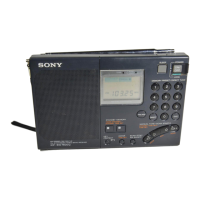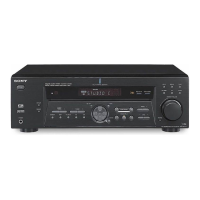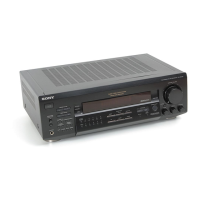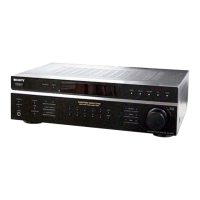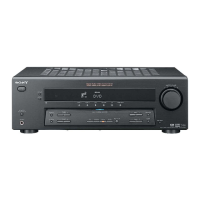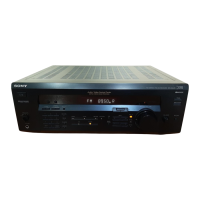
Do you have a question about the Sony STR-DE435 Operating Instructions (Receiver Component) and is the answer not in the manual?
| Frequency response | 10 Hz-100 kHz (+1 dB, -3 dB) |
|---|---|
| Total harmonic distortion | 0.09% (stereo), 0.7% (surround) |
| Speaker load impedance | 8 ohms |
| Video Connections | Composite video input/output |
| Weight | 8.1 kg |
| Speaker Impedance | 8 ohms |
| Tuning range | FM: 87.5 - 108 MHz, AM: 530 - 1710 kHz |
| Surround output | 100 W per channel (8 ohms, 1 kHz, THD 0.8%) |
| Input sensitivity (MM) | 2.5 mV |
| Dimensions | 430 x 145 x 295 mm |
| Input Sensitivity/Impedance | 2.5mV (MM), 150 mV (line) |
| Input sensitivity (line) | 150 mV |
| Signal to noise ratio (MM) | 80 dB |
| Output (line) | 150 mV |
Prevent fire/shock by not exposing unit to rain/moisture and not opening the cabinet.
Follow safety advice regarding liquids, qualified personnel, and installation space.
Verify voltage, disconnect when not in use, and use qualified service for cord changes.
Place unit for adequate ventilation, away from heat sources and direct sunlight.
Turn off before connecting components; clean with a soft cloth and mild detergent.
Check received items, insert batteries, and notes for remote operation and care.
Connect audio/video components using specified hookup procedures and rear panel descriptions.
Ensure power is off, mains lead is disconnected until connections are complete, and connections are firm.
Connect AM/FM aerials, grounding, and tips for improving FM/AM reception.
Connect audio components like CD and MD/TAPE players using audio cords.
Connect CD players and MD/Tape decks using audio signal flow diagrams.
Connect TV/LD players and VCRs for audio and video signals.
Connect front, rear, and centre speakers, and woofer for surround sound effects.
Use appropriate speaker cords, match polarity (+/-), and avoid short-circuiting.
Connect Dolby Digital AC-3 sources for enhanced audio playback.
Ensure speaker cords do not touch terminals or each other to prevent receiver damage.
Connect active woofers, additional front speakers, or TV speakers to the center terminals.
Connect the mains lead and use switched AC outlets, observing wattage limits for connected devices.
Ensure master volume is zero, front speakers are selected, and balance is centered before powering on.
Reset all stations, sound fields, and settings to factory default settings by holding the power button.
Position front, center, and rear speakers for optimal Dolby Pro Logic Surround sound.
Choose the correct center mode (PHANTOM, 3 STEREO, NORMAL, WIDE) based on speaker configuration.
Use the test tone feature to equalize speaker volume levels for surround effect.
Adjust rear and center speaker volume levels using the remote control.
Increase the rear speaker output range by 5dB for improved surround effect.
Learn how test tones are used to adjust speaker volume for optimal sound.
Control power with the I/ switch and select audio/video sources using function buttons.
Adjust master volume and mute sound using dedicated controls.
Configure front speaker output (A, B, or A+B) using the SPEAKERS selector.
Connect headphones and cycle through display information using specific buttons.
Activate surround sound, select modes, and adjust bass/treble for desired audio output.
Bypass tone controls by turning off sound field, tone, and bass boost for pure stereo sound.
Use PRESET/PTY SELECT, TUNING, and numeric buttons for direct or automatic tuning.
Utilize RDS PTY, RDS EON, FM/AM, and FM MODE for enhanced radio reception and information.
Use MEMORY, SHIFT, DIRECT, MENU, and +/- buttons for preset station management.
Use SET UP button to access CTR MODE and REAR GAIN settings.
Assign up to 8 characters to preset stations and program sources for easy identification.
Adjust sound parameters (SUR, BASS/TREBLE, DIMMER) for personalized audio experience.
Tune to radio stations directly by entering their frequency using numeric buttons.
Scan for and tune to receivable stations automatically using TUNING buttons.
Address STEREO indicator issues, tune for simulcast TV, and understand tuning intervals.
Save up to 30 FM/AM stations using memory and character selection.
Tune directly by number or scan through preset stations.
Store FM/RDS stations alphabetically and by signal strength using Auto-betical select.
Utilize RDS for station information like name, PTY, text, and time.
Cycle through PS, Frequency, PTY, RT, CT, and Sound Field information on the display.
Understand emergency alerts, missing RDS data messages, and text message limitations.
Use EON to automatically switch to traffic, news, or info broadcasts from networked stations.
Search for stations broadcasting specific programme types using PTY selection.
Reference table detailing available programme types and their descriptions.
Explore CINEMA, VIRTUAL, and MUSIC sound field types for different listening experiences.
Refer to Dolby Surround Setup for center mode and speaker volume adjustment.
Select desired sound field using SOUND FIELD MODE +/- buttons.
Understand the effects of CINEMA, VIRTUAL, and MUSIC sound fields for various content.
Receiver automatically recalls last sound field for each program source.
Customize sound by adjusting delay time (PRO LOGIC) and effect level.
Adjust rear/centre speaker volume and tone (bass/treble) for optimal sound.
Restore all customized sound fields to factory default settings.
Table detailing adjustable parameters (DELAY, EFFECT, REAR, CENTER, TONE) for various sound fields.
Table showing adjustable parameters for sound fields when using 5.1 CH/DVD inputs.
Assign up to 8 characters to preset stations and program sources for easy identification.
Record to MiniDisc or tape, or record video tapes with added audio from other sources.
Replace audio on video tapes by selecting different sources during recording.
Set the amplifier to automatically turn off after a specified time.
Troubleshoot no sound, poor audio, tuning failures, RDS issues, and reception problems.
Resolve issues with the remote control not functioning or recording failures.
Details power output, surround modes, frequency response, inputs, and outputs.
Lists tuner specs, power requirements, AC outlets, dimensions, mass, and accessories.
Explains surround sound elements, Dolby Pro Logic, and centre modes.
Defines terms like AC-3, 5.1 CH/DVD jacks, preset stations, and delay time.
Identifies rear panel jacks for antenna, CD, MD/TAPE, 5.1 CH/DVD, TV/LD, VIDEO, and MONITOR.
Details connections for speakers (Woofer, Rear, Center, Front A/B) and mains power.
Quick steps for receiving broadcasts, presetting stations, and scanning.
Summarized guidance for selecting components and using pre-programmed sound fields.
